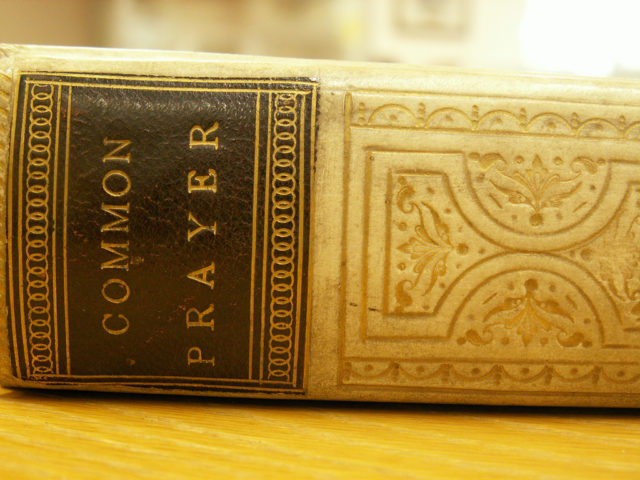
by Irene Lawrence
In its proposed report to General Convention, the SCLM has suggested four approaches to revising the Prayer Book, each of which has some merits and disadvantages. But they all include the assumption that we should continue to have a Book of Common Prayer. I would like to raise a question before the question: what is common prayer, and is a Book of Common Prayer right for our future, or should something else be our “unifying myth”? To make this question a little less heretical, note that some other Anglican churches no longer use the title—A New Zealand Prayer Book, for example—or explicitly use a number of other sources—the Church of England’s Common Worship series, or the Anglican Church of Canada’s Book of Alternative Services.
Full disclosure: I am a layperson who has been active in church life for some sixty years, sometimes professionally. My young adulthood was spent with the 1928 BCP, I eagerly participated in the Green Book and the Zebra Book, and I welcomed the 1979 BCP. I did not and do not want to return to the hierarchical and privileging theology, language, and piety of the 1928 BCP. But precisely because of my experience of the 1928 BCP, I have come to think, over the years of the 1979 BCP’s use, that it has had some unintended consequences—namely, that despite its greater theoretical theological inclusiveness as expressed in its baptismal liturgy, in actual Sunday-morning practice the 1979 BCP has ironically decreased “common” prayer and increased the liturgical gap between clergy and laity.
Historically, before the first Book of Common Prayer, only the clergy managed the multiple liturgical books—breviary, missal, manual, pontifical, pastoral, psalter, “pie,” all with variations from place to place—and of course in Latin. To make prayer “common,” Archbishop Cranmer combined all this into one English-language book. Because of printing, the book could be both reasonably small and, more importantly, uniform; the BCP’s simplicity (or, if you will, inflexibility) meant that the illiterate could learn it and the literate could read it. The intent was that it would be used by both lay and clergy, as appropriate to their order, for public worship in churches and for private and community prayer, such as in households, schools, hospitals, or other institutions. Thus it was “common” prayer, accessible to most and used by most. This understanding of “common prayer” as more or less uniform prayer for lay and clergy lasted through the 1928 BCP.
Over the centuries, the very strengths of this approach have become archaic. In particular, for our purposes here, its hierarchical ecclesiology assumed a qualitative difference between ordained and lay, between male and female, between colonist and indigenous, taking upper-class English/American culture as its norm. Because of its narrowness, it was inflexible, but its inflexibility meant that it was fairly user-friendly; everyone, even the laity, knew what to expect. It was, with all its faults, transparent; lay and clergy were equally bound by the limitations and restrictions of the BCP. The physical prayer book itself was compact, and personal copies, often godparent gifts, could be and were treasured and carried to church in pocket and purse—and actually used, if only on Sundays. Because of its simplicity and familiarity, an active layperson could in theory, with BCP and Bible (and a Hymnal, if they wanted to be fancy), plan any and all services of the church, even if their actual participation in those services was limited to an “amen” or two. Further, by 1928 and until the 1970s, Morning Prayer was the most common principal Sunday service in most Episcopal Church parishes. Even though these Sunday offices were led by clergy, lay leaders became familiar and comfortable with the daily offices; they were a feature of many rules of life for active laypeople (not only those who were affiliates of religious orders), and shortened offices, especially Evening Prayer, were commonly led at committee meetings or retreats by the lay leaders involved. All this resulted in a sense of ownership of the BCP liturgy among the laity.
Of course, this is something of an idealization. It is a description of a “one-prayer-book church,” which even then was a bit of a myth, especially in Anglo-Catholic circles. But it was a good representation, perhaps appropriate to its time in its expectation of a uniform society reflected in a uniform one-prayer-book church.
This has changed with the 1979 BCP, precisely as the result of its virtues, especially the “new mentality” in ecclesiology: a restoration of the laity as a full order of ministry and an appreciation of diversity as something to be welcomed instead of automatically suppressed. In a first attempt to be more inclusive, the 1979 BCP’s rites are much more flexible, a good thing in itself, but resulting in a physical book that is both bulky and user-unfriendly; the increased complexity of the liturgy has made it hard to follow. And ironically, the appropriate restoration of the Eucharist to its place as the church’s principal Sunday service, with an ordained presider always required, has decreased lay self-identification with public liturgical leadership. Simultaneously, the rise of desktop publishing and electronic data sharing has made the use of the actual BCP almost obsolete, at least at the main Sunday service. (Moving from paper to electronics may have as great an effect on liturgical practice as did printing for the first BCP.) Today, even if a liturgy is taken from the 1979 BCP, the congregation will almost certainly participate from a printed bulletin. The majority of active lay Episcopalians probably no longer own a BCP.
Anecdotal evidence: being pretty much “off-duty” from my own parish responsibilities this summer, I amused myself by attending the main Sunday service at other Episcopal churches, eight different churches in three dioceses. In every church, prayer books were in the racks, but only once did I have to touch one—to turn to the inside back cover where the prayers for a birthday and for an anniversary were pasted. In every case, bulletins with the complete service were provided, or at least the complete service as it applied to the lay congregation. Most lay people, even regular church attenders, now never lift a prayer book from its rack.
In pre-Reformation days, the multiple liturgical books were largely restricted to the clergy. Today, in contemporary terms, liturgical resources are again the domain of the professionals, most of whom are clergy. Consider the plethora or resources that we now use, some printed and some electronic only: the 1979 BCP, EOW1-5, BOS, LFF, HWHM (still?), GCW, IWBYYWBB, DPAS. We have rites approved by General Conventions but with no plans for publishing or promulgation, such as liturgical materials honoring God in creation and rites for the death of a pet. And, since the 2015 General Convention, the outline given in “An Order for Celebrating the Holy Eucharist” (BCP 400-401) may be used, even at the principal Sunday service. In my summer peregrinations, only one church used a BCP liturgy (printed in the bulletin, of course), and two others used an EOW liturgy. The other five used whole services or pastiches from US, Canadian, UK, New Zealand, and unidentified sources. No printed book can keep up with this. We are no longer, even as a myth, a one-prayer-book church.
But more important than the loss of the “Book” is the loss of “common” prayer in the old uniform sense. While there is little today that is theoretically inaccessible to a determined lay person, in actual practice the number and unpredictability of the resources available excludes most lay people from ownership of the liturgy. Thus the appropriate liturgical leadership of the clergy has effectively become an exclusive leadership. It is true that usually today the laity have more lines and bigger parts than in the 1928 BCP. But there is a new randomness to the liturgy; it is no longer the work of the people, but is more of a performance staged by the clergy in which the people are given, often generously, things to do and say. Ironically, this is completely antithetical to the intentions of the 1979 BCP baptismal theology/ecclesiology.
My crystal ball is no clearer than anyone else’s, but I don’t think a one-prayer-book church is likely to be recovered. That bird has flown, that ship has sailed, and that toothpaste can’t be squeezed back into the tube. If the old understanding of “common” prayer is dependent on uniformity and a one-prayer-book church, and if that is no longer possible or desirable in a church that rejects privilege and is attempting to be inclusive and inculturated, what does “common” prayer mean now? There are some hopeful signs. For one, both clergy and laity are more comfortable with extemporaneous prayer than before, or at least more willing to endure their discomfort. For another, outside the community liturgies, lay people have a great deal more authority than they used to—there are lay chaplains, for example (and not just seminarians doing internships), who have a great deal of autonomy in their liturgical practices; they are not restricted to one particular script or subject to constant oversight. Some parishes have operative liturgical committees with genuine lay input. And many parishes have developed interesting and effective ways to make the Prayers of the People truly the Prayers of the People.
We are in reality already in “trial use,” already experimenting in a chaotic way, but without organized feedback, or at best with feedback only on a parish level. Can we upgrade to perhaps a more controlled chaos, in which we talk to each other about what has worked for us and what hasn’t and why? Might we think of boundaries rather than scripts? Could we implement more formation for all ages so that more lay people have an understanding of the shape of the liturgy, their essential part in it, and its relation to Christian life and practice? Could we implement that formation enough so that clergy can rely on and trust their lay congregation in liturgical matters? Could we make all resources easily available to all, so all interested lay people could make contributions to the liturgy? Could we find a way for such interested lay people to genuinely be heard in the conversation about possible prayer book revision? Can we trust that the Holy Spirit works through lay people in the pews as well as clergy and church task forces? If so, we may be on our way to a new way to practice liturgical common prayer.
Irene Lawrence is an experienced (“old”) laywoman who has spent the last fifty years in the Diocese of California. Her misspent past includes an undergraduate degree in mathematics, a six-year stint in Liberia as a teacher-missionary of the Episcopal Church, an M.Div. from the Church Divinity School of the Pacific, a Ph.D. in Theology and Linguistics from the Graduate Theological Union, and a self-employed career as an Enrolled Agent (a federally licensed tax practitioner).

